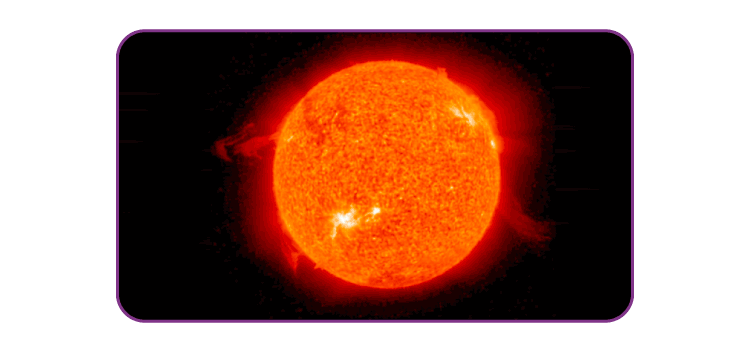The visible light is a small section of the electromagnetic spectrum. The electromagnetic spectrum includes all forms of radiation, ranging from the X-rays used at health centres to infrared radiation used in night vision tools.

Radiation in the electromagnetic spectrum is categorised by wavelength. Short wavelength radiation such as Gamma, X-rays, and ultraviolet is high energy and can be very dangerous. Longer wavelength radiation such as radio, microwaves and infrared are less harmful. This article will discuss infrared radiation and its characteristics in detail. Although infrared radiation is not visible, humans can sense it as heat. To experience infrared radiation “first-hand, put your hand next to a hot oven!
| Table of Contents
|
What Is Infrared Radiation?
Infrared radiation (IR), sometimes known as infrared light, is electromagnetic radiation (EMR) with wavelengths longer than those of visible light. Hence, it is undetectable by the human eye, although IR of wavelengths up to 1050 nanometers (nm) from specially pulsed lasers can be seen by humans under certain conditions. Infrared light extends from the suggested red edge of the visible spectrum at 700 nanometers to 1 millimetre. Most of the thermal radiation emitted by objects near room temperature is infrared. As with all EMR, IR carries radiant energy and behaves both like a wave and like its quantum particle, the photon. Depending on the wavelength and frequency, infrared is commonly divided into five categories as near-wavelength, short-wavelength, mid-wavelength, long-wavelength and far-infrared.
Characteristics of Infrared Radiation

- Infrared radiations is also referred to as heat or thermal waves or electromagnetic waves. This is because they have a heat-inducing property. Sometimes infrared rays are used in applications where heat production is required, like in infrared heaters or for therapeutic purposes where a patient requires physical therapy.
- Sometimes infrared rays are classified as near-infrared and far-infrared.
- Near-infrared rays are used in electronic applications like TV remote sensors and photography. Their applications can be similar to visible light applications since their wavelength ranges are close.
- Far infrared rays are more thermal. Anything generating heat gives out far-infrared radiation. Even the human body at 37°C gives off infrared radiations of around 800 nm wavelength.
Infrared Radiation Discovery

Infrared Radiation Wavelength and Frequency
We already know that the wavelength of infrared radiation is between 700 nm to 1 mm, which is between the red limit of the visible spectrum. But the following is the classification of bands based on the spectral range 1µm and 50µm:
- 1µm to 3µm, which is known as Band I or Short Wave Infrared
- 3µm to 5µm, which is known as the Band II or Middle Wave Infrared
- 8µm to 14µm, which is known as the Band III or Long Wave Infrared
Characteristics of Regions of Infrared
| Near-infrared |
|
| Short wavelength infrared |
|
| Medium infrared |
|
| Long-wavelength infrared |
|
| Far infrared |
|
Properties of Infrared Waves
Much of the energy from the sun reaches the Earth in the form of infrared radiation. The balance between absorbed and emitted infrared radiation has a critical effect on the Earth’s climate. Below, we have listed the properties of Infrared waves.
Transverse Waves
According to Serway’s College Physics, an infrared wave is said to be a transverse wave, i.e., the displacement of the wave is at the right angle to the direction of the wave propagation.
Wavelength
The wavelengths of infrared waves are unique and are usually measured in microns. A micron is defined as one millionth of a metre. The shortest wavelength of an infrared wave is about 0.7 microns. The longest wavelength of an infrared wave is 350 microns. According to studies, the upper limit of any infrared wave is 1000 microns.
Speed
The speed at which infrared waves travel is 299,792,458 m.s-1.
Particle or Wave?
According to quantum theory, infrared waves can exist as either a wave or a particle at the same time.
Absorption and Reflection
The absorption and reflection of infrared waves depend on the nature of the substance that the waves are made to strike. Materials such as ozone, carbon dioxide, and water vapour absorb infrared radiation. Snow and aluminium foil are materials that reflect infrared radiation.
Refraction and Interference
Infrared waves exhibit the property of refraction, making the waves experience a slight change in direction when the wave passes from one medium to another. Refraction properties of infrared waves can be noticed in the earth’s atmosphere. When two infrared waves with the same wavelength meet each other, they will interfere with one another.
Thermal Properties
Infrared radiation can be the source of heat as they have thermal properties. When infrared radiation strikes the oxygen or nitrogen molecules, it makes the molecules move faster as they gain more energy. So it can be concluded that infrared radiation makes materials hotter and can be used as a heat source.
Where Do We Use Infrared Rays?
We make use of infrared rays in the following:
- Communications: Infrared lasers are used for free-space optical communications as these are relatively inexpensive. These also find applications in the areas that are densely populated.
- Spectroscopy: Infrared vibrational spectroscopy is used for identifying molecules by analysing their bonds as the molecule vibrates at different frequencies. The unit used to express the radiation is cm-1.
- Astronomy: Optical components like mirrors, lenses and digital detectors are used to study the objects that are in space. These objects glow when they are exposed to radiated heat.
Uses, Applications, and Examples of Infrared Radiation
Following are the areas of use of infrared waves:
Heat Source
Two different industries use infrared radiation as a heat source, and they are:
- Medical uses: Infrared radiation finds application as a heating source. There are infrared saunas used to treat high blood pressure and rheumatoid arthritis. Infrared radiation is considered to be one of the safest methods of physiotherapy.
- Manufacturing industries: Industries which concentrate on manufacturing processes such as forming of plastics, curing of coatings, plastic welding, etc., use infrared heaters in place of contact heating and convection ovens.
Cosmetology Application
Infrared rays are widely used for cosmetic applications such as treating skin injuries, smoothing wrinkles, reducing the occurrence of dandruff, blackheads, etc. Infrared rays are used because they can penetrate the skin up to 3-4 mm. They also warm the skin resulting in improved blood circulation and a continuous supply of oxygen and other nutrients to the skin.
Astronomy
Astronomers use optical devices such as mirrors, solid-state digital detectors, and lenses to study objects from space with the help of infrared waves. The images from these optical devices are obtained with the help of an infrared telescope.
Massage Therapy
Infrared rays are used for warming the skin and for relaxing the muscles. Infrared rays are preferred because of their penetration quality through the skin.
Infrared Photography
Infrared filters are used for capturing pictures in infrared photography. This imaging is done for objects that are placed in the near-infrared spectrum. Most digital cameras use infrared blockers making the near-infrared appear as a purple-white colour in the final image.

Infrared Communication
Data transmission with the help of infrared radiation is very common in short-range communication. For encoding the data, infrared light-emitting diodes are used, which emit infrared radiation and are focused into a narrow beam with the help of a plastic lens. At the receiver end, a photodiode is placed to convert infrared radiation into electric current.
Interesting Facts About Infrared Radiation
1.Who discovered infrared radiation?
Sir Frederick William Herschel discovered infrared radiation.
2. When was infrared discovered?
Infrared was discovered in the year 1800.
3. What does infrared mean?
The term infrared is a Latin word in which infra means below. Also, red is the colour with the longest wavelength in the visible spectrum. Therefore, it is known as infrared.
4. Name the infrared radiation measuring instrument.
Infrared radiation is measured using an instrument known as an infrared thermometer.
5. How does infrared radiation work?
The emission of infrared radiation from an object is possible when heated. The atoms and the molecules in the object start to vibrate, thereby radiating infrared in the form of heat. When the objects are not hot enough to produce visible light, they radiate infrared. Also, heat production is independent of the temperature of the surroundings.
Extended Reading List
| Electromagnetic Waves: Radio Waves |
| Electromagnetic Waves: Gamma Rays |
Frequently Asked Questions on Infrared Radiation
List a few properties of infrared radiation.
Following are a few properties of infrared radiation:
- Infrared radiation, like all radiation, travels at a speed of 299,792,458 meters per second.
- Infrared light can exhibit both wave and particle nature at the same time.
- Depending on the nature of the material that infrared radiation strikes, it can either be absorbed or reflected.
- Infrared radiation increases the thermal energy in particles.
List a few medicinal effects of infrared radiation.
A few medicinal effects of infrared radiation are as follows:
- Used to reduce the inflammation of the throat, ear and nose
- Used as an aid in stress management
- Reduces pain arthritis
- It eases kidney function
How do we experience infrared radiation on a daily basis?
Infrared is a type of radiant energy that is invisible to the eyes; we can only feel it in the form of heat. All objects in the universe emit some level of IR radiation. Sun and fire are among the most obvious source of infrared radiation.
How to select infrared detectors?
Following are the guidelines that need to be followed when infrared detectors are selected:
- The temperature and wavelength of the object need to be measured.
- Photosensitivity and signal to noise need to be noted. Also, for signal noise reduction, the infrared detector must be cooled using either thermoelectric, mechanical, or cryogenic cooling.
- Depending on the application of the infrared detector, response speed and chopping frequency need to be recorded.
- When infrared detectors are used in the optical systems, the size and the geometry of the active area plays a vital role.
- Infrared detectors are available in various packages and these packages are metal can package and ceramic packages.
What is the classification of the infrared detector?
The infrared detector is classified into two:
- Thermal type: Heat supply to thermal type detector happens through the infrared energy and the photosensitivity is independent of the wavelength. The thermocouple is an example of a thermal type infrared detector.
- Quantum type: This can be either an intrinsic type or extrinsic type. The detection performance is higher when compared to the thermal type. Intrinsic type is further divided into two and they are photoconductive type and photovoltaic type. The photosensitivity of these detectors is dependent on the wavelength.
What are the characteristics of infrared radiation?
- Invisible to human eyes: This is considered to be one of the characteristics of infrared radiation and is also useful for security purposes. The drawback of the invisibility of infrared radiation to the human eye is that designing optical instruments becomes difficult.
- Small energy: The energy of infrared radiation is equal to the vibrational and rotational energy of the molecules. This characteristic is used in the identification of the molecules.
- Long-wavelength: The transmission becomes better as there is less scattering through the medium.
- Infrared radiation can be emitted from all kinds of objects.

Comments